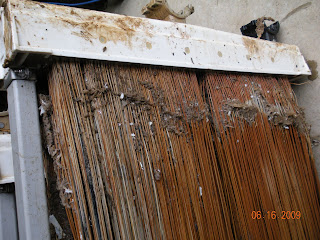



 ruct a 4 stage Bardenpho wastewater treatment facility out of an existing aerobic digester and utilize a primary clarifier as our secondary clarifier. A large number of temporary hoses, pumps and wiring needed to be installed in October of 2009. By February 2010, the facility was seeded and charged with magnetite and all of the bugs worked out to the point where reliable and accurate data began being recorded. The picture on the right is the BioMag reactor's first three stages of treatment. Notice the black color of the activated sludge which is a result of the biomass being impregnated with magnetite.
ruct a 4 stage Bardenpho wastewater treatment facility out of an existing aerobic digester and utilize a primary clarifier as our secondary clarifier. A large number of temporary hoses, pumps and wiring needed to be installed in October of 2009. By February 2010, the facility was seeded and charged with magnetite and all of the bugs worked out to the point where reliable and accurate data began being recorded. The picture on the right is the BioMag reactor's first three stages of treatment. Notice the black color of the activated sludge which is a result of the biomass being impregnated with magnetite.
.jpg) This picture on the left is of Steve Woodard , inventor of BioMag and employee of CWT, A Maryland Department of the Environment (MDDOE) employee, and yours truly. This picture was taken during a tour of the BioMag equipment after a presentation of data to MDDOE, engineers and the owner of the Cascade, MD facility.
This picture on the left is of Steve Woodard , inventor of BioMag and employee of CWT, A Maryland Department of the Environment (MDDOE) employee, and yours truly. This picture was taken during a tour of the BioMag equipment after a presentation of data to MDDOE, engineers and the owner of the Cascade, MD facility.
As a result of the initial findings, the highest priority item was to get the sludge thickening operation under control. The waste sludge holding tank was typically operated at over half full and without the ability to aerate the tank, anaerobic conditions were created which impacted sludge thickening efficiency, odors and filtrate quality. The sludge holding tank was emptied and now the staff keeps the tank empty daily. This significantly reduced the BOD and TN loading on the SBR's and allowed the staff to eliminate one of four SBR's from operation. Odors have also been reduced significantly.
It was apparent the SBR's had accumulated large amounts of debris (screening) as a result of the headworks barscreen being out of service for several months. The WPCA fun
As a result of these changes to the operation of the plant it is expected the WPCA will save significant dollars on power, consumables and avoid paying nitrogen fees to the State. Once I have some firm figures, I will post the anticipated cost savings.
 debris, hair and rags that shorten the life of the individual strands through a process called delamination. In essence what happens is the rags force their way inbetween the membrane strands which puts stress on them causing them to stretch, delaminate and ultimately break. Once the strands delaminate or break, you begin to pull suspended solids into the permeate which results in compliance problems.
debris, hair and rags that shorten the life of the individual strands through a process called delamination. In essence what happens is the rags force their way inbetween the membrane strands which puts stress on them causing them to stretch, delaminate and ultimately break. Once the strands delaminate or break, you begin to pull suspended solids into the permeate which results in compliance problems. Here, Steve puts the finishing touches on the new membranes just prior to testing. Thanks to the Applied Water Team of Aram, Steve and Roger for their work on this project. Thanks also go out to the owners representatives Donna and Don!
Here, Steve puts the finishing touches on the new membranes just prior to testing. Thanks to the Applied Water Team of Aram, Steve and Roger for their work on this project. Thanks also go out to the owners representatives Donna and Don!

